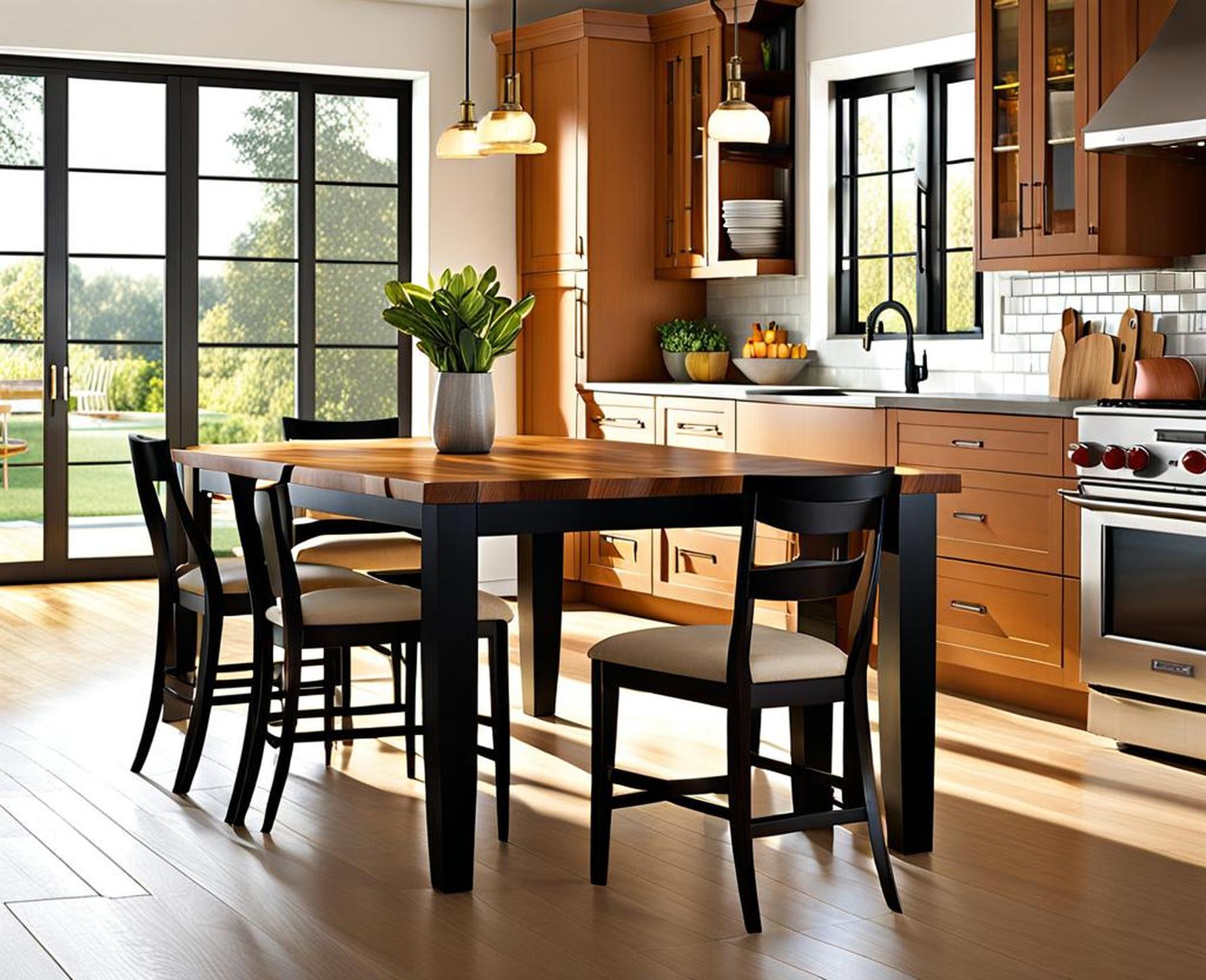When designing your dream kitchen, getting the right table height should be a top priority. An optimally sized kitchen table and matching chairs can transform mealtimes from awkward to inviting.
But with so many options out there, how do you choose dimensions that work for your space? Get ready to learn the ideal table height for comfort, legroom, and seamless circulation.
What is the Standard Kitchen Table Height?
In the United States, the typical kitchen or dining table height falls between 28-30 inches. Chairs tend to be around 18 inches tall, leaving a 12 inch difference between the tabletop and the seat.
This standard size range has proven optimal for legroom and comfort when seated at the table. The ample leg clearance allows easy access and movement around the table without bumping knees.

Why the Standard Dimensions Matter
That 12 inch height gap between a standard 18 inch chair and 28-30 inch table gives most adults ample legroom. You won’t have to slouch or stretch to reach your meal.
The standard table height also allows for comfortable long-term seating for dining and entertaining. Extensive time in a hunched or cramped position can lead to back, neck, and shoulder pain.
Because they suit the average adult’s proportions, standard table and chair heights can accommodate a range of people comfortably. Few adjustments or specialized furniture are needed.
How to Choose the Right Table Height for Your Kitchen
Selecting the ideal kitchen table height for your space depends on several factors.
Consider Your Chair Height
A general rule of thumb is to choose a table around 12 inches taller than your chair height. Standard chair seat heights for kitchens and dining areas are commonly 18 inches. With a little simple math, that makes a table height of around 28-30 inches (12 inches taller than 18) ideal for most kitchen chairs.
If you have bar stools or chairs outside the norm, adjust your table height accordingly to allow proper legroom.
Factor in Countertop and Cabinet Height
Make sure to measure your kitchen counters and cabinetry when selecting table height. Standard counter height is 36 inches. Base cabinets are commonly 34-1/2 inches tall.
Avoid choosing a table so tall that it collides with your countertop or cabinetry. Leave several inches of clearance for a smooth workflow.
Measure Your Existing Kitchen Layout
If replacing an existing kitchen table, carefully measure its height along with your current chair dimensions. While it’s not always essential to match them exactly, your existing table height provides a good baseline.
Small bump-ups or reductions of an inch or two can make a big difference in improving legroom and comfort.
Accommodate Your Needs
If you regularly host guests with mobility issues, a slightly taller table height around 32 inches may offer better wheelchair clearance. Families with small children can benefit from a table on the shorter side, around 26 inches.
Whatever your needs, choose a height that works ergonomically for your household.
Matching Table and Chair Styles
When it comes to aesthetics, choose chairs and a table that coordinate. Complementary colors, materials, and design styles will give your kitchen dining area a pulled-together feel.
Chairs must also be appropriately scaled to your table. Measure to ensure adequate seating room between table edges and chair backs or armrests.
Tips for a Comfortable, Functional Kitchen Table
Beyond getting the height right, a few other tips will ensure your kitchen table setup is optimized for legroom, seating, and easy circulation:
- Choose a round or oval table shape. The curved edges allow smoother traffic flow.
- Allow at least 36-42 inches of clearance around each seat.
- Arrange seating to avoid cutting off main circulation paths.
- Select chairs with legroom-friendly designs. Avoid chairs with stretchers or front legs that block knee space.
- Consider a table with leaves to expand for large gatherings.
Common Questions about Kitchen Table Height
Here are answers to some frequently asked questions on finding that perfect kitchen table height:
What if my chairs are taller or shorter than 18 inches?
Simply adjust your table height calculation by the inch or two difference. Get a table around 12 inches taller than your actual chair height.
How do I measure current table height?
Use a tape measure to measure from the floor to the highest point of the tabletop surface. For accuracy, take measurements at both ends and the middle.
What if I want bar stool seating?
For a kitchen island or counter bar table, you’ll typically need a table height of 40-42 inches to properly accommodate bar stools.
What about a kitchen island table height?
Kitchen island tables are often slightly taller at around 36 inches. This allows them to match standard 36 inch high countertops.
Getting your kitchen table and seating height right improves comfort, mobility, and enjoyment of the space. Use standard table and chair dimensions as a starting point, then tailor to your room layout and needs.
Keep sight of the goal: seamless legroom, pain-free long sits, and space to navigate around the table with ease. With the right dimensions, your kitchen table can become a beloved gathering place for years to come.
